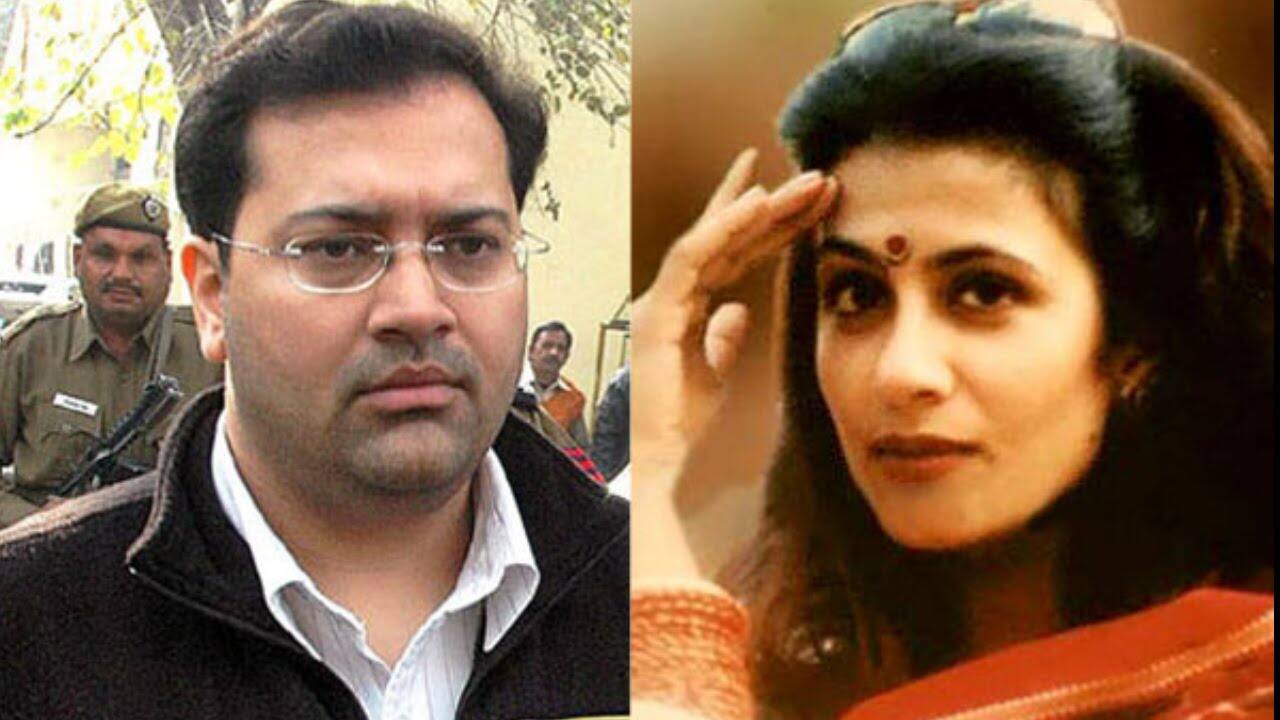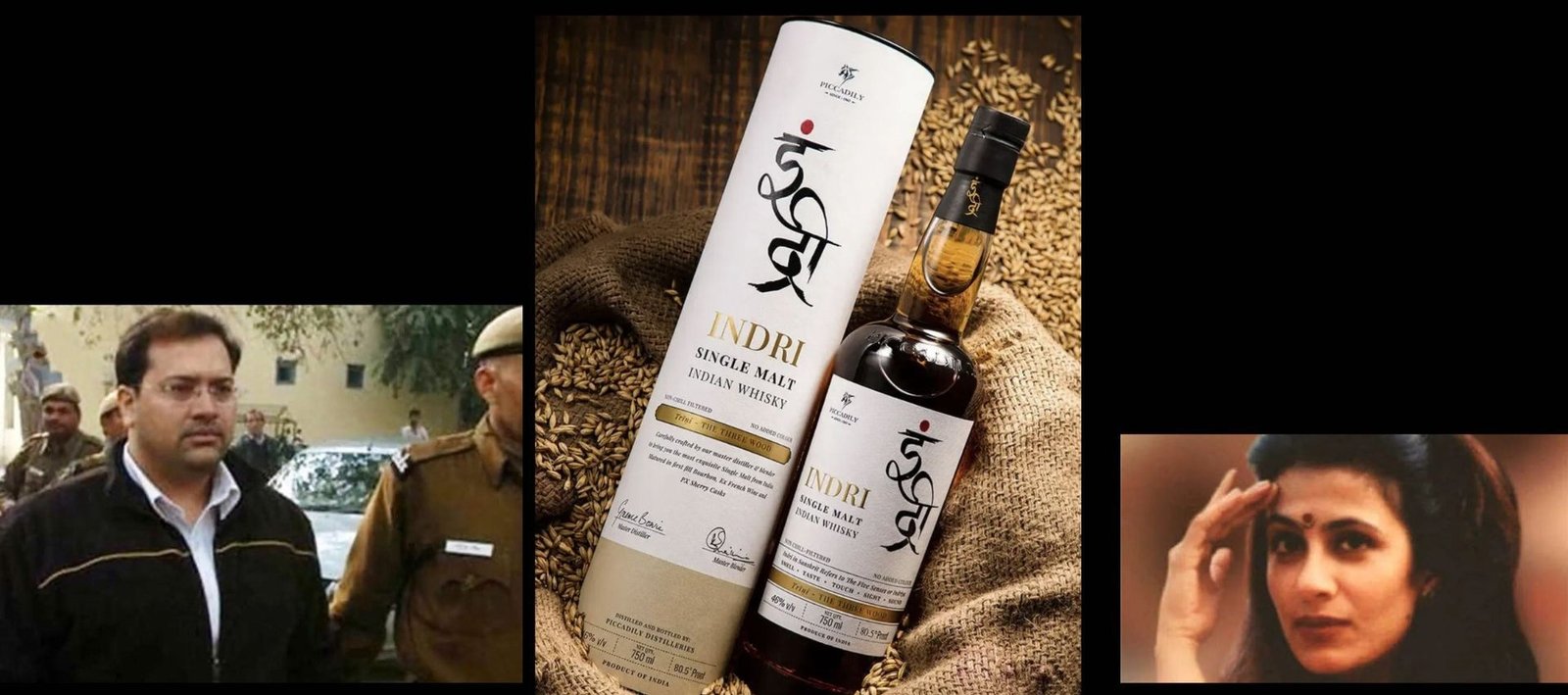Indri Whisky, celebrated as India’s pride on the global stage, has a story that’s as intriguing as it is unsettling. The world of whisky, with its smoky allure and golden hues, is often a tale of craftsmanship, tradition, and celebration. Yet, sometimes, even the finest spirits carry shadows in their lineage. Behind the accolades and its peated perfection lies a name etched in infamy – Manu Sharma.
A Murder That Shook the Nation
April 29, 1999. A sweltering night in Delhi’s elite social circles turned tragic at Tamarind Court, a posh restaurant owned by socialite Bina Ramani. Jessica Lal, a 34-year-old model moonlighting as a bartender, was shot point-blank for refusing a drink. The shooter? Manu Sharma, alias Siddhartha Vashisht, the son of a powerful Haryana Congress leader, Venod Sharma.
Jessica’s death was not just another crime; it proved to be a wake-up call for India’s judiciary and its people. The murder, committed with the brazenness of privilege, exposed the sharp inequalities in the justice system. For six long years, Manu Sharma dodged conviction, aided by wealth and political influence, until public outcry and relentless media coverage forced the law to act. In 2006, he was sentenced to life imprisonment.
But even the bars of Tihar Jail couldn’t dim the reach of his family’s empire.
Whisky and Redemption. The Sharma Family Business
Fast forward to the present. Manu Sharma, now going by the name Siddhartha Sharma, is a free man, and his family’s business ventures have flourished. Among them is Piccadily Agro Industries Limited (PAIL), a company with roots stretching back to 1953. In 1994, PAIL pivoted to the distillery business, producing what would later become the globally acclaimed Indri Whisky.
Indri, named after a village in Haryana, is a single malt whisky celebrated for its peated smokiness—a glory to Indian craftsmanship rivaling global whisky giants. Its Diwali Collector’s Edition 2023 was crowned “Double Gold Best In Show” at the prestigious Whiskies of the World competition, beating over 100 international contenders.
Yet, as the world toasted Indri’s success, few knew of the man behind the scenes. Company filings reveal that Siddhartha Sharma, under his previous alias Siddhartha Vashishta, has been a promoter of PAIL since 2011-12—while still serving time for murder. Today, he remains the largest individual shareholder, steering the company toward ambitious global ventures.
From India to Scotland
In 2021, PAIL took its ambitions overseas, acquiring Portavadie Distillers and Blenders in Scotland with a £15 million investment. The distillery, set in the eerie “ghost village” of Polphail, marks Sharma’s long-cherished dream of establishing a foothold in the world’s whisky capital.
Interestingly, Sharma’s criminal past could have posed significant hurdles in obtaining the necessary licenses. Yet, those obstacles appear to have been surmounted, allowing PAIL to script a new chapter in the global whisky market.

The Jessica Lal Case
In the dead of night on April 30, 1999, amidst the clinking glasses and hushed whispers of Delhi’s elite, a tragedy unfolded that would shock a nation. At an unlicensed bar hosting actors, politicians, and socialites, 34-year-old Jessica Lal was shot dead—a single bullet to the head ending her life and igniting a firestorm of public outrage.
The bar had run out of alcohol by midnight, yet Sharma and his companions—Alok Khanna, Amardeep Singh Gill, and Vikas Yadav—demanded drinks. Jessica refused their request, even as Sharma brandished a 1,000-rupee note in an attempt to coerce her. When his money didn’t work, he pulled out a .22 pistol and fired two shots. One missed; the other struck Jessica in the head.
As Jessica lay lifeless, Sharma and his friends vanished into the night, their connections and resources shielding them from immediate capture. It wasn’t until May 4, 1999, that the police apprehended Khanna and Gill. Sharma himself was arrested two days later, on May 6.
Justice Delayed and Manipulated
The legal proceedings crawled forward. On August 3, 1999, the police formally charged Sharma with murder and tampering with evidence. His accomplices faced charges of conspiracy, destruction of evidence, and harboring a fugitive. But what followed was a masterclass in evasion, bolstered by the Sharma family’s wealth and influence.
Manu Sharma, the son of Venod Sharma, a Congress-nominated MP, wielded significant political and financial clout. Witnesses who initially pointed fingers at him suddenly recanted their testimonies. Key evidence, including the murder weapon, was inexplicably “lost.”
In a damning verdict on February 21, 2006, the court acquitted Sharma and his associates, citing a lack of credible evidence. The judgment declared the police’s case insufficient, while Sharma’s confession—later retracted—was deemed inadmissible.
A Nation’s Fury Ignites
The acquittal was a breaking point. The urban middle class, galvanized by anger and frustration, took to the streets. University students organized protests via SMS, an unprecedented use of technology for social activism at the time. Protesters demanded accountability, justice, and an end to the impunity enjoyed by the wealthy.
The outcry forced the judiciary to reconsider. In December 2006, the Delhi High Court reversed the lower court’s acquittal, sentencing Sharma to life imprisonment. The case became a watershed moment, exposing the deep rot of privilege and corruption within India’s justice system.
From Convict to Whisky Mogul
Manu Sharma served time but was released early on “good behavior” in 2020. Today, he’s better known as Siddhartha Sharma, a promoter of Piccadily Agro Industries Limited (PAIL), the family business behind the globally acclaimed Indri Whisky.
The irony is hard to ignore: a man once emblematic of the misuse of privilege now presides over a brand that’s won accolades for excellence. PAIL has expanded its operations internationally, acquiring a distillery in Scotland, while Manu Sharma’s name has been carefully rebranded, much like the smoky, refined flavors of Indri Whisky.
The Spark That Ignited a Movement
The murder of Jessica Lal was not just the tragic end of a young woman’s life; it became a rallying cry for an India struggling with the weight of privilege, corruption, and a broken justice system. The public outrage, fueled by relentless media campaigns and citizen protests, transformed the case into a pivotal moment for the country’s judicial conscience.
The case dragged on for years, marred by witness retractions, tampered evidence, and judicial apathy, culminating in the acquittal of Sharma and his accomplices in February 2006.
This verdict sparked widespread anger, with headlines screaming, “No one killed Jessica.” It was a turning point for India’s urban middle class, which refused to let wealth and political connections triumph over justice.

The Role of Media and Citizen Action
NDTV, a leading 24-hour news channel, launched a campaign urging viewers to petition for a retrial. The response was overwhelming: more than 200,000 text messages flooded the station, demanding justice for Jessica.
Inspired by the film Rang De Basanti, students organized a candlelight vigil at India Gate on March 4, 2006, a symbolic act that resonated across the country. Just days later, on March 7, a group of 150 college students marched down Parliament Street, chanting “Jessica, Jessica” and holding placards that read, “Wake up from Ur Insane Slumber” and “We are in a country where you can get away if your dad is a politician.”
The protests weren’t confined to Delhi. Surya, a Brazilian cosmetics company, joined the movement by distributing “Justice for Jessica” temporary tattoos and creating a website to collect names and emails of supporters. Fashion designers, models, and Jessica’s friends and family led a week-long T-shirt campaign emblazoned with messages demanding a re-investigation.

The Judiciary Responds
Under immense public pressure, police commissioner KK Paul petitioned the High Court for a review of the case. On March 22, 2006, the court issued warrants against the nine defendants.
The tide turned further when Tehelka magazine aired an exposé in September 2006, revealing that witnesses had been bribed to retract their statements, with Manu Sharma’s father, Venod Sharma, implicated in the scandal.
Finally, on December 15, 2006, the Delhi High Court convicted Sharma based on existing evidence, and on December 20, he was sentenced to life imprisonment. The Supreme Court upheld this verdict on April 19, 2010, confirming Sharma’s guilt beyond doubt.
From Tragedy to Transformation
The Jessica Lal case became a watershed moment in India’s legal and social history. It spotlighted the power of media, the strength of collective citizen action, and the ability of a democracy to self-correct under pressure.
Yet, the story does not end here. In 2020, Manu Sharma was released from Tihar Jail on grounds of good behavior, a move that reignited debates about privilege and justice.
Who Was Jessica Lal?
Born on January 5, 1965, Jessica Lal was a vibrant model in New Delhi, known for her grace and charisma. On the night of her murder, she was one of several models working at an unlicensed bar near the iconic Qutub Minar in Mehrauli. The bar, owned by socialite Bina Ramani, became a focal point of investigations, with Ramani and her family facing legal scrutiny for operating without permits and allegedly tampering with evidence.
The Last Bit. Indri Whisky A Bitter Aftertaste?
The Jessica Lal case was more than a crime—it was a reflection of a fractured society where justice often bends under the weight of influence and even in these long years nothing seems to have changed much.
While Sharma’s past may seem neatly tucked away, the memories of that fateful night and the subsequent miscarriage of justice linger like an unwelcome shadow.
This is not just about a whisky or a murderer turned businessman. It’s a reflection of a society that is still struggling with the uneasy coexistence of redemption and accountability. Can a name so deeply associated with one of India’s most shocking crimes ever truly be separated from its past?
As whisky enthusiasts savor the smoky notes of Indri, one can’t help but wonder, does the spirit taste just as sweet when its history leaves a bitter aftertaste?




